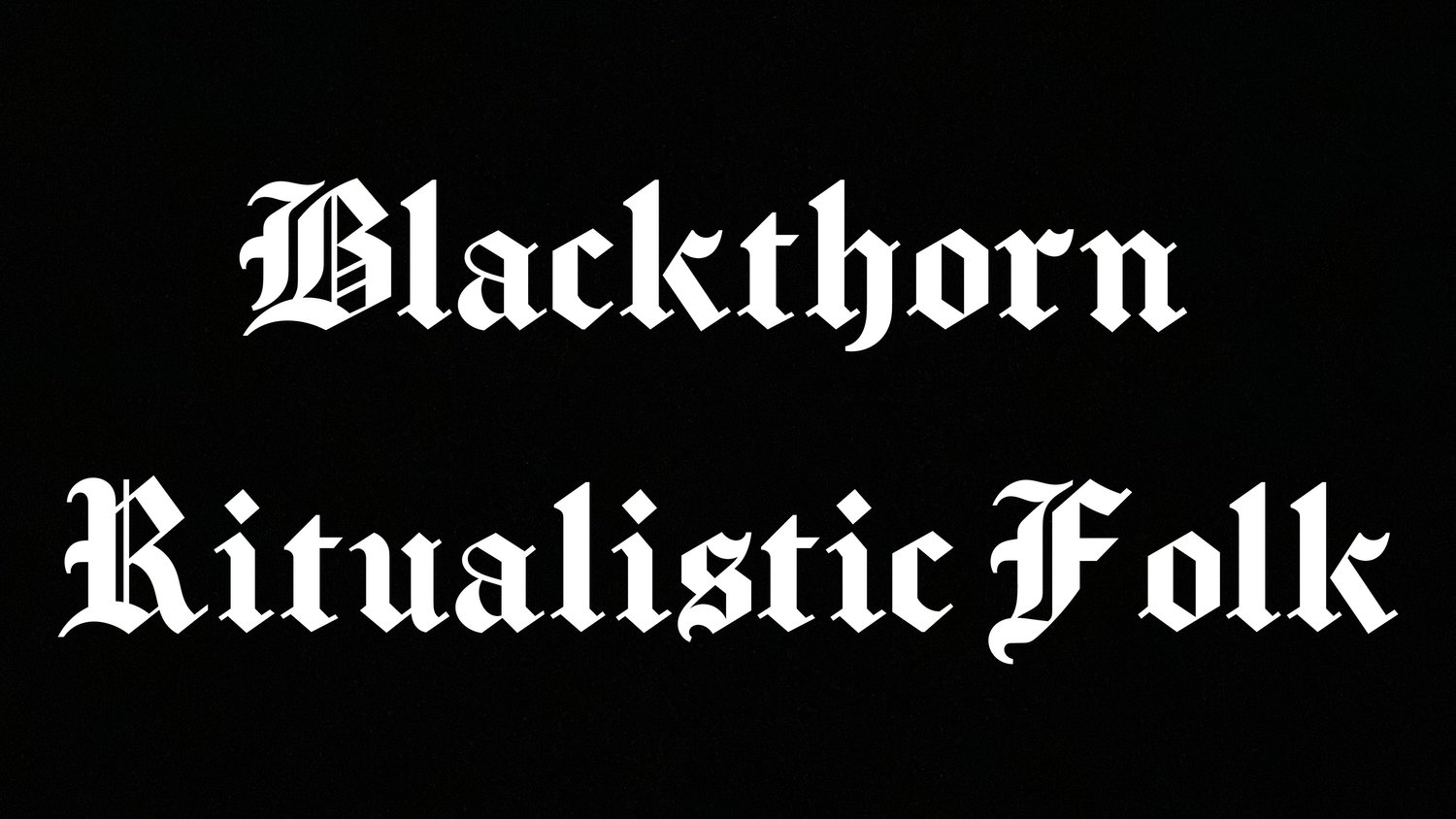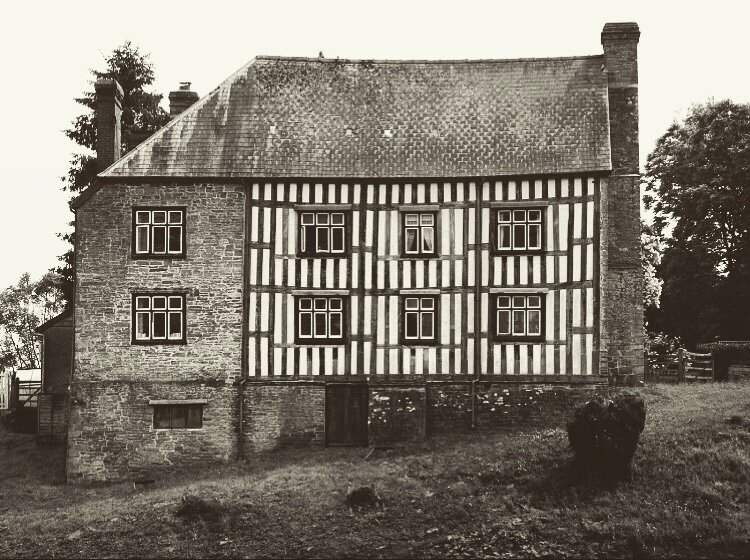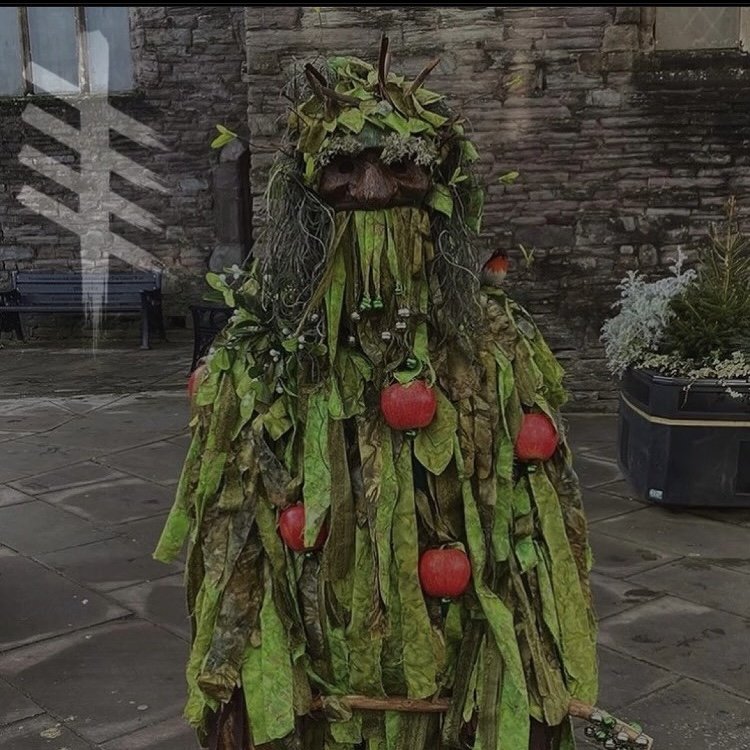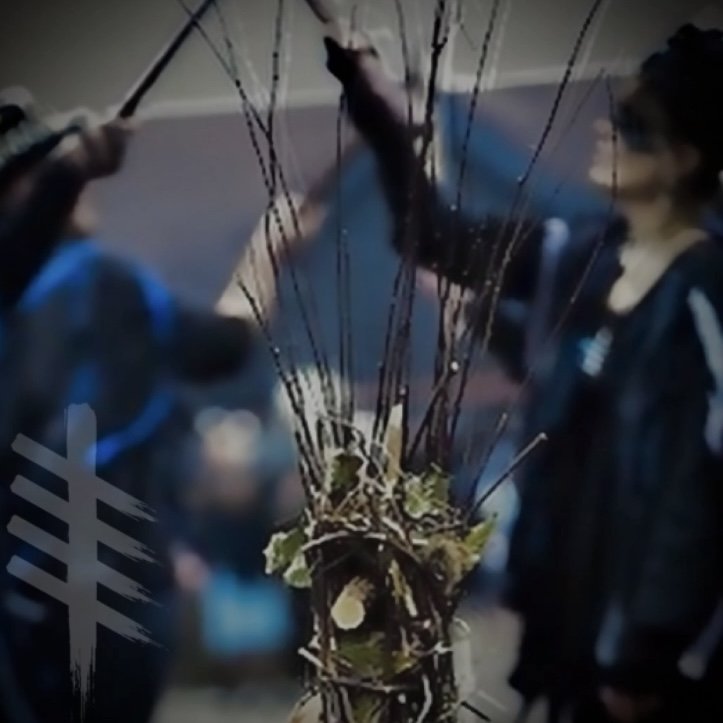The legend of Black Vaughan
(Black Vaughan is our main beast and comes out with us on almost all our gatherings)
In St Mary’s church, Kington, Herefordshire you will find the exquisite alabaster and marble tomb of Ellen and Thomas Vaughan.
Thomas Vaughan nicknamed “Black Vaughan” because of his black hair or perhaps due to his black nature was a 15th century lord at Hergest Court, Kington, Herefordshire. He lived there with his wife Ellen Gethin of Llanbister, Radnorshire who was know as Ellen “The Terrible” for it was said she was a wicked lady. She once dressed as a man in order to take part in an archery contest just so she could kill her young cousin - she shot him in the heart with an arrow.
Thomas supported Edward in the Wars of the Roses, but while marching toward Banbury in 1469, to aid the Yorkist cause at the Battle of Edgecote, he was captured by the Lancastrians. The Lancastrians took Thomas to Pontefract and beheaded him, it’s said as his head toppled from his shoulders and hit the ground a blood curdling howling could be heard as his black bloodhound scooped up the head and set off in the direction of Hergest Court. His body was returned to Kington and laid to rest to the church of St Mary and in due course Ellen joined him. But death was not the end for Black Vaughan, for he began to make his presence felt again, his spirit was restless and wreaked havoc amongst the town.
The legend says he would appear in many forms, namely as a large fly which tormented horses and a black dog which would chase livestock until they fell down dead with exhaustion. He would also appear as large black bull where he would run through the market place destroying the stalls and charging townsfolk. While in bull form he once burst in to Kington’s church sending the congregation running, frightened for their lives. Villagers of Kington began to move away and the town began to struggle, eventually there was a call for an exorcism to be performed to rid the spirit for good.
Twelve priests accompanied by a wise man from the Black Mountains, a young mother with a day old child (to show innocence) and as many local people as dared to come were present for the said exorcism. The Twelve priests assembled in the court and drew a circle, inside they all stood with bibles and lighted candles in hand, praying. The ghost was very resolute, and came among them roaring like a bull. ‘Why are you so fierce, Mr Vaughan?’ asked one of the priests ‘Fierce I was a man, fiercer still as a devil’, roared Vaughan, and all the candles were blown out except one, held by a frail old priest. He had taken one of his boots off and hid the candle inside which kept it from going out, all the time praying hard until at length the violent spirit was quelled, and brought down to the humble size of a blow fly, they quickly shut him up in a snuff box’. The ghost made one last humble petition “Do not bury me beneath water’. The priest immediately had him enclosed in a stone box which was then thrown into Hergest Pool. After that, the only sighting of Vaughan’s spirit was that of a black dog which has haunted generations of the Vaughan family, appearing before them to signify imminent death.
Local people around Kington take the stories of the ghost of Black Vaughan as more than just legend. Many refuse to walk near his home of Hergest Court at night, for fear of seeing something unnatural.
Here is our beast Black Vaughan in the spirt form of the black bull.
The Apple Tree Man
(The Apple Tree Man comes out at our wassail events, so look out for him)
Photo by Sin Eater.
In English folklore, he’s the spirit of the oldest apple tree in the orchard and whom the fertility of the orchard is thought to reside. Every orchard has one and this spirt would look after the farmers fortunes and oversee the blossoming and ripening of the fruit, to ensuring a good crop. Many stories tell of the apple tree man frightening off thieves who would enter the orchard attempting to steal apples around harvest time. When bringing in the last harvest it’s said that you should always leave three apples on each tree, one for the fairy, one for the fae and one for the apple tree man.
Some believe he has a connection to the legendary Green Man. He was also sometimes referred to as “Lazy Lawrence” (nothing to do with him being actually lazy though). It was common to say that Lazy Lawrence has got your legs if you found a person stumbling around drunk on cider.
The folklorist and “chime child” Ruth Tongue collected folktales about the Apple Tree Man. In one story a man offers his last mug of mulled cider to the trees in his orchard on Christmas Eve. He is rewarded by the Apple Tree Man who reveals to him the location of buried gold. In another tale a farm cat who was curiously exploring some fields finds itself in an orchard where the Apple Tree Man cautions her to go back home, because folks were coming to pour cider on his roots and shoot guns in to his branches to drive away the witches.
So next time you venture into an old orchard be wary, keep an eye out for the apple tree man, waes hael!!
The Darkest Ooser
(pronounced oo-zuh)
(The Ooser and his keeper appear at our Samhain gatherings)
In 𝟷𝟾𝟿𝟷, 𝘵𝘩𝘦 𝘖𝘰𝘴𝘦𝘳 𝘸𝘢𝘴 𝘧𝘪𝘳𝘴𝘵 𝘣𝘳𝘰𝘶𝘨𝘩𝘵 𝘵𝘰 𝘱𝘶𝘣𝘭𝘪𝘤 𝘢𝘵𝘵𝘦𝘯𝘵𝘪𝘰𝘯 𝘪𝘯 𝘋𝘰𝘳𝘴𝘦𝘵, 𝘸𝘩𝘦𝘳𝘦 𝘪𝘵 𝘪𝘴 𝘵𝘩𝘰𝘶𝘨𝘩𝘵 𝘵𝘰𝘩𝘢𝘷𝘦 𝘰𝘳𝘪𝘨𝘪𝘯𝘢𝘵𝘦𝘥 𝘧𝘳𝘰𝘮. 𝘛𝘩𝘦 𝘖𝘰𝘴𝘦𝘳 𝘸𝘢𝘴 𝘢 𝘭𝘢𝘳𝘨𝘦 𝘸𝘰𝘰𝘥𝘦𝘯 𝘮𝘢𝘴𝘬 𝘸𝘪𝘵𝘩 𝘢 𝘩𝘶𝘮𝘢𝘯 𝘭𝘪𝘬𝘦 𝘧𝘢𝘤𝘦, 𝘣𝘶𝘭𝘭𝘩𝘰𝘳𝘯𝘴, 𝘣𝘦𝘢𝘳𝘥, 𝘢 𝘳𝘰𝘶𝘯𝘥𝘦𝘥 𝘣𝘰𝘴𝘴 𝘣𝘦𝘵𝘸𝘦𝘦𝘯 𝘵𝘩𝘦 𝘦𝘺𝘦𝘴 𝘢𝘯𝘥 𝘢 𝘩𝘪𝘯𝘨𝘦𝘥 𝘭𝘰𝘸𝘦𝘳 𝘫𝘢𝘸 (𝘸𝘩𝘪𝘤𝘩 𝘢𝘭𝘭𝘰𝘸𝘦𝘥𝘵𝘩𝘦 𝘮𝘰𝘶𝘵𝘩 𝘵𝘰 𝘰𝘱𝘦𝘯 𝘢𝘯𝘥 𝘤𝘭𝘰𝘴𝘦).
𝘛𝘩𝘦 𝘰𝘳𝘪𝘨𝘪𝘯𝘢𝘭 𝘮𝘢𝘴𝘬 𝘥𝘪𝘴𝘢𝘱𝘱𝘦𝘢𝘳𝘦𝘥 𝘢𝘳𝘰𝘶𝘯𝘥 𝟷𝟾𝟿𝟽 𝘭𝘦𝘢𝘷𝘪𝘯𝘨 𝘵𝘩𝘦 𝘮𝘺𝘴𝘵𝘦𝘳𝘺 𝘰𝘧 𝘪𝘵𝘴 𝘸𝘩𝘦𝘳𝘦𝘢𝘣𝘰𝘶𝘵𝘴 𝘢𝘯𝘥𝘪𝘵𝘴 𝘱𝘶𝘳𝘱𝘰𝘴𝘦 𝘣𝘦𝘩𝘪𝘯𝘥. 𝘖𝘯𝘭𝘺 𝘵𝘸𝘰 𝘷𝘦𝘳𝘺 𝘢𝘨𝘦 𝘥𝘢𝘮𝘢𝘨𝘦𝘥 𝘱𝘩𝘰𝘵𝘰𝘨𝘳𝘢𝘱𝘩𝘴 𝘩𝘢𝘷𝘦 𝘦𝘷𝘦𝘳 𝘣𝘦𝘦𝘯 𝘧𝘰𝘶𝘯𝘥, 𝘮𝘢𝘬𝘪𝘯𝘨 𝘵𝘩𝘦 𝘖𝘰𝘴𝘦𝘳 𝘰𝘯𝘦 𝘰𝘧 𝘉𝘳𝘪𝘵𝘢𝘪𝘯'𝘴 𝘮𝘰𝘳𝘦 𝘮𝘺𝘴𝘵𝘦𝘳𝘪𝘰𝘶𝘴 𝘧𝘰𝘭𝘬 𝘭𝘦𝘨𝘦𝘯𝘥𝘴.
Photo by Tavis Amosford
The Green Man
(The green man joins the side on Beltane morning)
The Green Man’s image can be found carved in wood or stone, in churches, chapels, abbeys and cathedrals. The face is normally of a male and it comes in many guises. From a head covered in green foliage known as “foliate head” or “leaf mask”, the entire head is composed of leaves which grow with the skin, from the forehead, eyebrows, moustache, beard and cheeks.
It is also found as a head, which looks to be peering through leaves, where the foliage is not part of the face itself but surrounds it. Skull versions of the green man can be found, where flowers sprout from the eyes. These are normally found on graves stones. A grave slab in Shebbear, Devon is a great example of this. The “disgorging” or “uttering” green man is usual found in rural counties. It has foliage spewing or growing through its mouth, nose and eye sockets, which bear leaves, flowers and fruit, these were most popular in Britain.
There is some speculation that the green man could be in fact swallowing, inhaling or devouring nature and is an symbol of evil. Some believe the green man is related to pagan vegetative deities, a type of nature spirt.
The name ‘Green Man’ was first used by Lady Raglan in March 1939 in an article "The Green Man in Church Architecture", The Folklore Journal. Before this, they were known just as ‘foliate heads’.
Some say that there is a link between the figure Robin Hood. You will also see similar versions of the green man, such as the Jack-in-the-Green and the King of the May, who you will find at celebrations on May 1st.
Some say it could be the image of a dead body laid to rest among a forest floor, the leaves growing through the head and around it.
The carvings could symbolise a memento mori, translated into English: "Remember you must die”, a reminder that your body will be placed into the earth, a medieval Latin Christian theory and practice reflecting on mortality. A reminder that death awaits all men. This could also explain why they are mostly found on medieval religious buildings. The foliage symbolises that where there is death there is also rebirth and new life will naturally spring out of our remains as it feeds the soil and produces life again. That it is an ongoing cycle, a reminder that humans will die along with the plants during the harshness of winter but spring will aways emerge and with it bring hope, new life and food.
Unfortunately, the green man’s meaning and message has been lost with time and all we can do is speculate on what he represented. For most, it’s a symbol of growth and rebirth, the eternal seasonal cycle of the coming of spring and the life of Man.
Winterfylleth
Winterfylleth one of our folk beasts who has been brought back to life to gallop once again through the borderlands. She joins the side for our dance called The Black Nag which is our border version of an old English folk dance.
In Herefordshire, twenty four horse skulls were discovered screwed to the underside of the floorboards in Portway Inn. A further twenty seven horse skulls were discovered under a property in Peterchurch. Some say these were placed there for reasons of superstition, believing that the skulls would bring good luck to the household. Another reason is that it allegedly improved the acoustics of a room - the hollow skulls resonating under the floor, when danced upon.
Winterfylleth (Ƿinterfylleþ) was the Anglo-Saxon or Old English name for the month of October, which is the same month Blackthorn was birthed.
Twiggy Witch
Our Twiggy Witch is inspired and in honour of the amazing British Cryptids films, check our guest appearance in the video below
👇🏻
Turoń
Turoń from Polish folklore represents the dark forces of nature but also fertility & abundance of nature. It is a “winter bull” which is traditionally made from two blocks of wood covered in wool, fur or painted black, it’s then attached to a wooden pole, horns added which were sometimes made from sticks but most often real horns (oddly not always from a bull) it also has a jaw mechanism which creates a snapping sound & finally a cloth to cover the person inside. Turoń has roots in ancient Slavic winter rites, the name is derived from the word tur, meaning aurochs (a large wild Eurasian ox made extinct in Britain in the Bronze Age & the last one was killed in Poland in 1627.)
Turoń walks hunched over & would accompany a group of carol singers (Polish: kolędnicy) during the Christmas season in rituals of pre-Christian Slavic roots known in English as koliada (Polish: kolęda).
Traditionally the Turoń would grow heavy with fatigue during the ritual. Turoń would collapse then everyone would try to wake it by poking it or by lighting a bundle of hay as a kind of an incense (undoing of its hex) but most often the best way to revive the beast was by giving it a sip of vodka & the turoń would suddenly recover & begin to frolic again, which often announces the end of its visit.
A popular folk rhymes, sung or recited during the “walking with turoń” rites, claimed that where the turoń will go, crops will later grow (e.g. “gdzie turoń chodzi, tam żytko rodzi / gdzie jego stopy, tam staną kopy”).
You’ll find Turoń roaming around our wassails in January.










